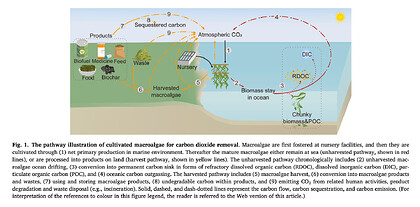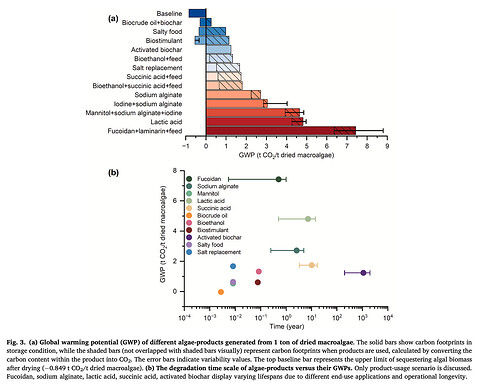Carbon dioxide removal dilemma of macroalgae products: Evidence from carbon footprint and profitability
This week, we deep dive into a paper recently published in the Journal of Cleaner Production. The study was conducted by a team led by Tingting Jiao from the College of Environmental Science and Engineering of the Ocean University of China in Qingdao (China).
This study investigates the environmental and economic trade-offs of using macroalgae (seaweed) products for carbon dioxide removal (CDR), critically assessing whether macroalgae-based products truly contribute to negative carbon emissions when considering their full life cycle. Macroalgae has been proposed as a promising nature-based solution due to its ability to absorb CO₂ through photosynthesis. Various macroalgae-derived products, such as biofuels, bioplastics, and livestock feed, have been explored for their economic potential and environmental benefits. However, while macroalgae absorb CO₂ during growth, its ultimate impact on atmospheric carbon depends on how the biomass is processed and used. Many of these products release CO₂ back into the atmosphere, reducing their effectiveness as long-term carbon sequestration solutions. This creates a dilemma between profitability and climate benefits, as economically viable applications may not necessarily lead to sustained carbon removal.
The study conducts a comprehensive life cycle assessment (LCA) of different macroalgae-derived products, including biofuels, bioplastics, and animal feed additives. Findings reveal that, although macroalgae cultivation captures CO₂, the processing and downstream use of these products often result in carbon re-emissions, challenging the assumption that they provide long-term carbon sequestration benefits. A fundamental trade-off emerges: products that are more profitable (such as biofuels) tend to have a higher carbon footprint, whereas those with better CDR potential (such as deep-sea sequestration of macroalgae biomass) are less economically viable. This creates a dilemma where financial incentives do not necessarily align with optimal climate outcomes, calling for policy interventions to align economic incentives with climate benefits. For example, improvements are possible by taking measures like massive utilization of renewable energy, breeding carbon-richer macroalgae species, and enhancing manufacturing technological efficiencies. Without proper regulatory frameworks or carbon credit mechanisms, macroalgae-based CDR strategies may struggle to scale effectively while maintaining environmental integrity.
Here is a list of the main takeaways from this paper:
- Macroalgae absorbs CO₂ but does not always sequester it long-term – Many products release carbon back into the atmosphere, limiting their climate benefits.
- Profitability and carbon removal are often at odds – More profitable macroalgae-based products, like biofuels, tend to have higher carbon footprints.
- Deep-sea sequestration has high CDR potential but low economic appeal – Without financial incentives, large-scale implementation remains challenging.
- Life cycle assessment (LCA) is crucial for evaluating macroalgae’s true impact – A full emissions analysis reveals that not all applications contribute to net-negative carbon removal.
- Policy support is needed to align markets with climate goals – Carbon credits or subsidies could help prioritize macroalgae solutions with real CDR benefits.
Read the full paper here: Carbon dioxide removal dilemma of macroalgae products: Evidence from carbon footprint and profitability

